new posts in all blogs
Viewing: Blog Posts Tagged with: Nepal, Most Recent at Top [Help]
Results 1 - 10 of 10
How to use this Page
You are viewing the most recent posts tagged with the words: Nepal in the JacketFlap blog reader. What is a tag? Think of a tag as a keyword or category label. Tags can both help you find posts on JacketFlap.com as well as provide an easy way for you to "remember" and classify posts for later recall. Try adding a tag yourself by clicking "Add a tag" below a post's header. Scroll down through the list of Recent Posts in the left column and click on a post title that sounds interesting. You can view all posts from a specific blog by clicking the Blog name in the right column, or you can click a 'More Posts from this Blog' link in any individual post.

By: Priscilla Yu,
on 12/31/2015
Blog:
OUPblog
(
Login to Add to MyJacketFlap)
JacketFlap tags:
Books,
earthquake,
CDC,
natural disaster,
Place of the Year,
nepal,
POTY,
humanitarian aid,
*Featured,
Yellow Book,
Science & Medicine,
Health & Medicine,
travel medicine,
CDC Health Information for International Travel 2016,
Place of the Year 2015,
POTY 2015,
aid workers,
Megan O’Sullivan,
Ronnie Henry,
Add a tag
Just before noon on 25 April 2015, a violent 7.8-magnitude earthquake rocked Nepal, killing almost 9,000 people and injuring more than 23,000. Hundreds of aftershocks followed. Entire villages were razed, destroying communities and leaving hundreds of thousands of people homeless.
The post Traveling to provide humanitarian aid: lessons from Nepal appeared first on OUPblog.

By: Lizzie Furey,
on 12/24/2015
Blog:
OUPblog
(
Login to Add to MyJacketFlap)
JacketFlap tags:
Religion,
hinduism,
hindu,
Place of the Year,
nepal,
POTY,
*Featured,
Place of the Year 2015,
Axel Michaels,
Homo ritualis. Hindu Ritual and Its Significance for Ritual Theory,
Nepal earthquake,
Kathmandu Valley,
Add a tag
With the devastating earthquake in Nepal on 25 April 2015, not only humans but also gods became shelterless. The famous Car Narayan or Fourfold Vishnu Temple in Patan is one of the many temples that completely collapsed. It was constructed in the classical Newar “pagoda” style with two pyramidal roofs and an inner ambulatory by a local ruler, Purandara Simha, in 1565.
The post When gods become shelterless: rituals and reconstructing temples in post-earthquake Nepal appeared first on OUPblog.

By: Priscilla Yu,
on 12/10/2015
Blog:
OUPblog
(
Login to Add to MyJacketFlap)
JacketFlap tags:
Books,
Religion,
Politics,
hinduism,
Asia,
caste system,
Place of the Year,
nepal,
POTY,
*Featured,
women president,
Oxford Atlas,
Oxford Atlas Place of the Year,
Place of the Year 2015,
Anne T. Mocko,
Bidya Bhandari,
Demoting Vishnu,
POTY 2015,
Ritual Politics and the Unraveling of Nepal's Hindu Monarchy,
Sital Niwas,
UML,
Add a tag
Nepal has had an extraordinarily eventful 2015. It has been rocked by catastrophic earthquakes and burdened by a blockade from India, but it has also (finally) passed a new constitution and elected its first female head of state, Bidya Devi Bhandari, who took office in October.
The post Welcome to Sital Niwas, Madame President appeared first on OUPblog.

By: Connie Ngo,
on 11/12/2015
Blog:
OUPblog
(
Login to Add to MyJacketFlap)
JacketFlap tags:
Books,
Asia,
Place of the Year,
Oxford Atlas of the World,
nepal,
POTY,
*Featured,
Quizzes & Polls,
Subtopics,
Oxford Atlas Place of the Year,
history quiz,
Place of the Year 2015,
PotY2015,
Add a tag
As voting for the Place of the Year 2015 continues, we would like to take a moment to highlight one of the shortlist nominees: Nepal.
The post Place of the Year 2015 nominee spotlight: Nepal [quiz] appeared first on OUPblog.
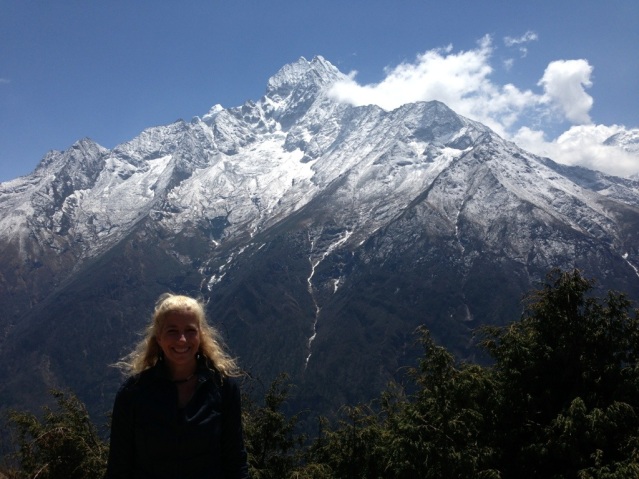
Where have I been?
Around the world, in ninety days.
A research trip for a screenplay that was supposed to be five weeks long where I traveled to Australia and Indonesia turned into so much more. Thanks for your patience while I was away. I’m in the process of understanding all the changes that I’ve been going through and putting words to the experience. Surprisingly I’ve had no jet lag when I returned nearly three weeks ago and am instead working very hard on the screenplay and some film documentaries too. There’s so much to process. The trip was life affirming as well as life changing. You’ve been great supporters of my work and I’m thrilled to have you on this journey with me. One of the places I least expected to go was Mt. Everest, and as fate would have it, while I was there the worst disaster in the history of the storied mountain unfolded. An avalanche took the lives of 16 sherpas. They were family members and friends of the sherpas who trekked with me on the Everest trail. Sometimes stories come to you. This was perhaps the biggest story I’d ever been caught up in and it influenced my entire experience in Nepal, which started off as a humanitarian trip to provide dental care to “yakland” kids (children who live above 10,000 feet) some who are orphaned (due to the ten year civil war there) and some victims of human trafficking. This is but a small a window into one of the unexpected, but wonderful stops on my journey.
I haven’t updated my about page, because I really like the fact that I had written there that one of my dreams was to travel to Indonesia. And it’s so nice when dreams come true. I don’t think I’ll update it with my new dreams yet. It’s nice to savor and celebrate moments like this. *pops the cork off the champagne bottle* *pours you a glass* Now about that stand up comedy routine…
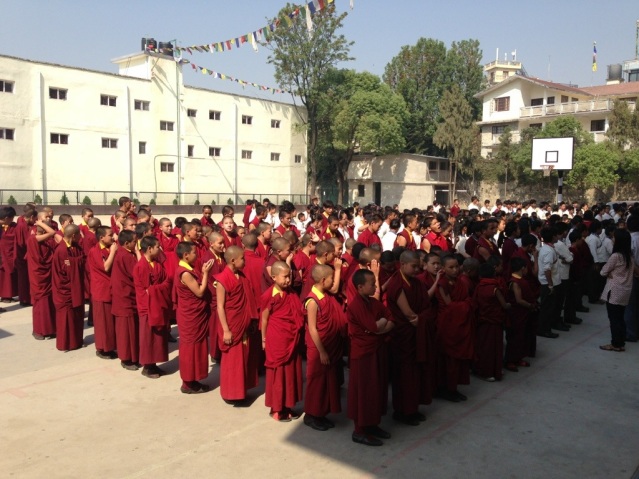
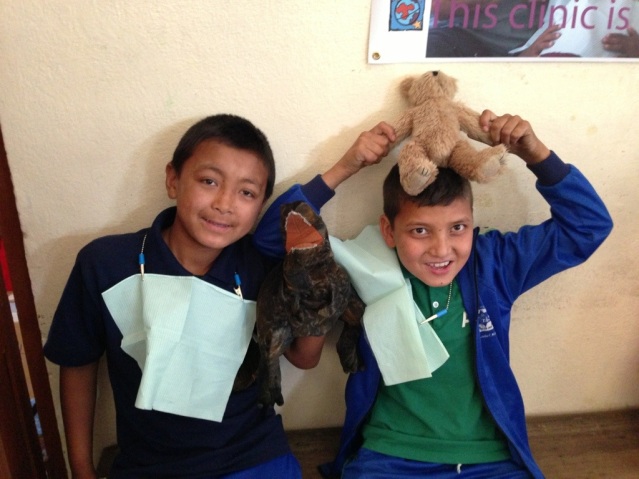


I had the privilege of interviewing award-winning journalist Dan Archer, the creator of the Kickstarter project Graphic Journalism on Human Trafficking in Nepal.
Project: Graphic Journalism on Human Trafficking in Nepal.
Talent/Project Manager: Dan Archer
Days to Go: 5
Goal: $12,000
The spiel: For the last three years Dan Archer has been teaching a graphic novel project through the Creative Writing department at Stanford University. Archer has been nominated for an Eisner for his collaboration on Yiddishkeit with the legendary Harvey Pekar. Dan is the first comics journalist to be elected to the John S. Knight Jourlism Fellowship. You can read his journalistic pieces on various websites like Huffington Post, Alternet, The Guardian UK, Presente, Operamundi(Brazil), Expressbuzz (India) and Independent World Report.

An investigative journalism project to report on human trafficking in Nepal in real time in the form of a webcomic and graphic novel.
Dan is going to use the funds for his travel in Nepal to gather testimony from people who have been directly effected by human trafficking. He has a staff of translators, fixers and survey givers he will pay with the money raised. This is something that has never been done before, and if that’s not enough, he will give backers the opportunity to watch him report/create the comic in real time. Real time online art videos have become very popular and I think builds a bigger bond between fans and the creators. It should be interesting to see how this comic is created and his commentary as he makes it.
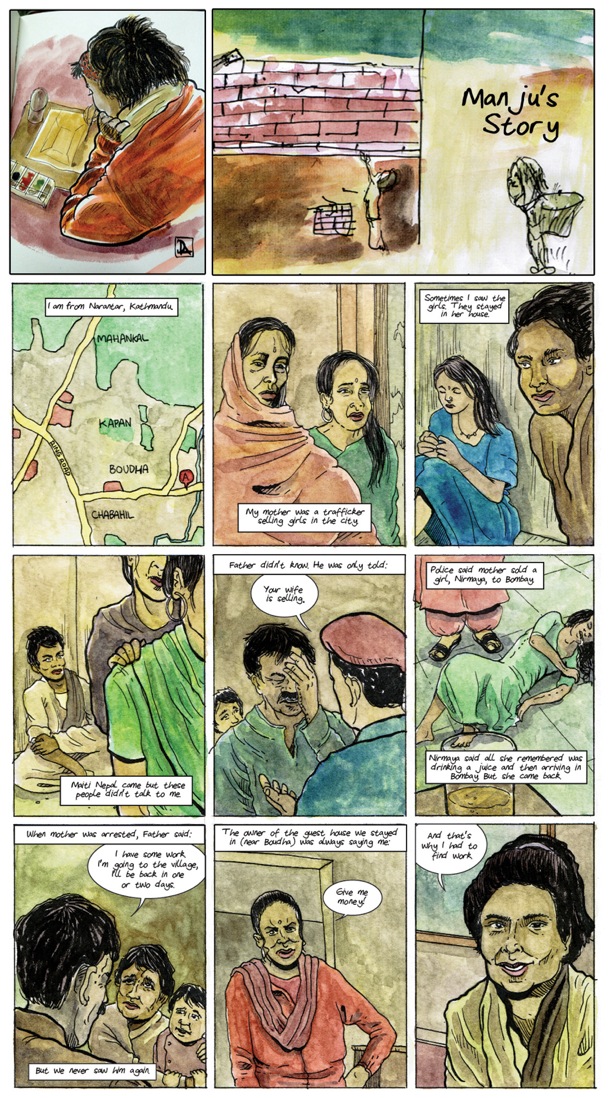
Archer is offering prints of individual web comics, and interactive PDFs with multimedia content like audio and video footage. If you kick in $50 you get the paper back and for only an extra $25 you can get the book personalized and a sketch. The book will be published in English and Nepali. The price seems a little high but I think readers and potential backers can have faith that if this project succeeds this will be a rewarding experience for everyone.
Mr. Archer was kind enough to take time from his busy schedule from interviewing people that have been slaves and give an interview and elaborate what will go in to making this project come to fruition.
Henry Barajas: With so many problems in the world like climate change, food shortages and political corruption, why do you feel the need to report the social injustice in Nepal?
Dan Archer: When I started making non-fiction comics I focused on the larger issues like political corruption (in my graphic history of the Honduran Coup), prop 8, the military-industrial complex in the US and so on, but I slowly gravitated towards telling personal stories, adapted from first-hand testimonies from people whose voices were often absent from mainstream media. I became interested in human trafficking after my 2009 project through the Fulbright program with the wonderful Olga Trusova, in which we used comics to tell the stories of seven trafficking survivors from eastern europe. After finishing that project in 2010, I continued working on trafficking/violence against women in the US, but it was when I spoke to Madhu during my Knight fellowship that I saw an opportunity to use comics in an environment where literacy levels were low and a significant chunk of the target audience was children.
How are you going to find people that are going to willingly share their stories without any kind of reprisal?
A mixture of different approaches: I’m pairing with a professor at Vanderbilt University who ran a huge study on trafficking as part of her Phd at Stanford in 2009, who already has experience and a pre-built network we can use; through NGOs; through a colleague who was on the same journalism fellowship I was on at Stanford in 2010 who has extensive links to Nepal’s community radio stations (having essentially built them from scratch over the past decade), which is ideal for reaching out to local populations; through schools; and through the sheer interest that people have in the project, the response to which has been positive across the board.

Are there any taboos or misconceptions about this situation in Nepal and human trafficking that the general public has that you want to clear up?
At the risk of painting the issue in too broad brush strokes yes, most definitely. The dramatic rescue approach, careening into locations where trafficking is reported and pulling out the victims, is no longer an option – or at least an option that will be beneficial in the long-term without a significant improvement in after-care infrastructure. In those cases, despite them generating media attention for all the drama involved, one of two things tend to happen: either the survivors, after being released from custody, find themselves back in the same desperate economic situation that led them to resort to trusting a dalal (trafficker) in the first place (with the added challenge of now having to overcome their community’s stigma at having been trafficked) or they are detained in custody (often because they’re the only ones at the scene of the crime, the traffickers long gone by then) and dependent on the same criminals who enslaved them to bail them out. Which is of course added to their ongoing bill, and cements the notion that only the trafficker cares about them. Trafficking is also not only sex trafficking, which makes up only a fraction of incidences, and was more prevalent a decade ago. Bonded labour and domestic servitude amongst children is a huge problem that many papers perhaps feel lacks the emotive punch of sex trafficking. Plus the risks of workers going abroad (especially to the Gulf/Qatar etc) are huge, and few protection systems are in place for those who risk everything to leave their country and provide for their families.
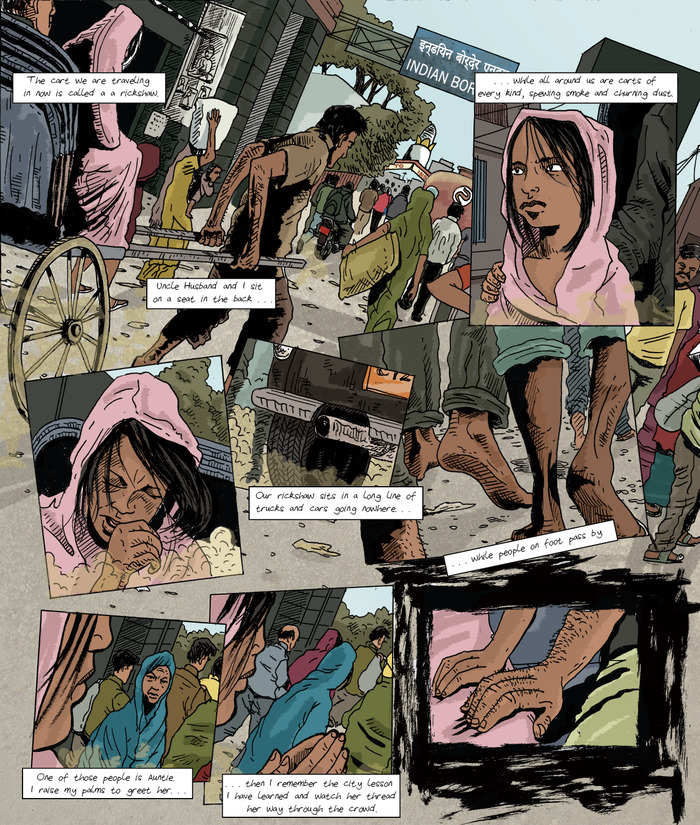
This project could have been made as a documentary or a novel and probably received more notoriety. What gave you the idea to use this visual narrative to shed light on this subject?
The age-old question about comics being intrinsically comic! Comics (or graphic novels, which non-comics folks seem to find more palatable) are increasingly being taken more seriously: from Art Spiegelman’s Pulitzer or Maus in 92 to Marjane Satrapi’s Persepolis being required reading for US troops stationed in the middle east to Joe Sacco recently being awarded the Ridenhaeur prize for Investigative Reporting for Footnotes in Gaza – slowly the prejudice is being overcome.
Comics effectively give the creator the power of director, cameraman, set designer, writer, actor etc – but without any budgetary strings. So you’re able to work with source material in a way that gives the reader a unique reading experience: they control the pace of the narrative as only they have the agency to piece together the narrative from one panel to the next. Unlike film, which is more passive. I wanted to tell the story of trafficking not from the cliched POV of an outsider looking in, but through their eyes, using their words – and drawn visuals give me the ability to corroborate what I’ve sketched with the interviewee to ensure that I get the images as close to their recollection as possible. Visual narratives are also very malleable: I can pull out the words and make the stories work wordlessly if need be, or translate the text into different registers to suit the audience. Plus it’s very low-tech media: screening a documentary might work at a one-off event, but I wanted to produce something that would have a lasting benefit, that could be shared long after we leave the villages we’re working with: and comics are the ideal medium for that. Not to mention the power of connection that sketching someone in the field has, as opposed to putting recording equipment in their face.
What goes in to preparing for this journey on a logistical and mental level?
Having Madhu (the colleague I mentioned in the previous question) as a local with lifelong experience of working nationwide has been invaluable for getting things off the ground – at a logistical and linguistic level (my Nepali is getting there, slowly but surely…) His wife Jaya is also a prominent figure in Nepali media and a staunch advocate of women’s rights, and the pair of them have gone out of their way to lend me their expertise and knowledge as I’ve set things up. I also reached out to a ton of different NGOs before I left to set up meetings and interviews for when I arrived, so was able to get a fast sense of the lay of the land. Mentally, the challenge of being in an entirely foreign situation actually appealed to me (I studied languages at university way back when, so I love the chance to immerse myself in another culture), and of course there was the thrill (and risk) of trying to report in a more real-time fashion using comics, as well as to run a quantitative assessment of comics in the field for the first time. So there’s a lot at stake in a relative short timeframe (I’m here til May) – something that’s all too metaphorically represented in the tick tick tick of the Kickstarter campaign, which ends on Saturday.
If this is successful, what other social injustices do you plan to plan to cover using comic’s journalism?
Comics are very versatile and would be well suited to any sort of grass-roots awareness campaigns in countries facing the same barriers to visual media access as Nepal. Economic injustice within the globalized supply chain (indirectly related to trafficking) is another area I’m interested in working on, and in fact I’ll be stopping over in Delhi to visit some of the failed resettlement projects outside the capital to cover a story on that next week.

Comics Journalism is becoming rapidly popular, where do you see this going in the future?
There’s the undeniable rise of digital comics journalism from the likes of Sarah Glidden, Susie Cagle, Wendy MacNaughton, The Illustrated Press, Andy Warner or Matt Bors’ work as comics journalism editor for Cartoon Movement, plus the launch of tablet-targeted publications like Erin Polgreen’s Symbolia, which has been cleverly optimized to deliver interactive comics journalism content to the ipad. I think the future will see more interactivity incorporated into this sort of work – we’re already seeing embedded audio and hotlinks (via soundcloud and thinglink), but soon it will feature animation, multimedia and so on.
I’m not really aware of the history that comics have in Kathmandu—are there any other comics to come from there or is this the first?
I confess I’m not too familiar with the local scene here either – there have been some illustrated attempts at covering trafficking, but they’ve typically been very generic in their approach, often collapsing different fictional stories, which I don’t think resonate with the same power as real stories told by real people. There’s also a history of satirical/humorous comics, like the “Yak and Yeti” strip that used to run in one of the big dailies in Kathmandu, but it’s a comics strip more in keeping with the setup/conflict/punchline rhythm of strips like Garfield. I’m definitely interested in finding local artists doing the same kind of work as I am.
Henry Barajas is the co-creator, writer and letterer for El Loco and Captain Unikorn. He has also written and lettered short stories for two successful Kickstarter projects: Unite and Take Over: Stories inspired by The Smiths and Break The Walls: Comic Stories inspired by The Pixies. He is the Newsroom Research Assistant for The Arizona Daily Star and was nominated for the Shel Dorf Blogger of the Year award. You can follow him on Twitter @HenryBarajas.
One of the most interesting things about picture books is the story behind the books — where the seeds of ideas came from and how they grew. As promised, I am posting about how my new book, Same, Same but Different came to be. I hope it gives you some good book-energy and that hearing about my work-process is helpful.
Unlike some tales I’ve heard of children’s book authors who woke up from a dream in urgency to scribble down a story appearing to be a gift from the beyond, I had to travel to the other side of the world 3 times to find this book. The first time, I found only the title. The second time, I found the experience. And the third time, I found the content and research.
In 2000, eleven years ago, my friend Maria and I wandered around SE Asia for a month, and I jotted down a saying, “Same, Same but Different” that we heard in Thailand. My favorite part of the trip was playing with kids in a remote village in Northern Thailand — which inspired me to return.
In 2002, I traveled to Nepal to volunteer at a school. I lived with a family of 14. Everything seemed SO so foreign to me, and I LOVED that. On the second day with my family, I was given a bucket of cold water and soap. Hmmm…did she want me to clean?
“Bucket shower,” she said. “Same, same but different.” There was that saying again…
I had been collecting M. Sasek’s “This is…” book series and had a secret daydream of picking up where he left off. I doodled ideas for “This is Nepal” in my sketchbook. I knew I wanted to make books from my travels.
I feel like it took me a while to find my way at the school — what did I have to share? I wasn’t an English teacher or a musician (like the amazing previous volunteer I heard so many stories of). So for awhile, we simply played and became friends with each other. We became a beautiful part of each other’s worlds.


After observing an art class with twenty 4th graders copying Mickey Mouse in their notebooks that the teacher had drawn on the blackboard, I decided to ‘play’ art with them every day, all day. The school building was dark. The rooms were small and cramped. There were even rats the size of obese American cats lurking in the playground corners. So we went on walks everyday to draw temples, people, chickens, cows, mountains, Buddhas, flowers, and more. We painted self-portraits and each other. We painted a 60 ft long mural in the playground. The school was buzzing with art. I emailed my friends back home and asked them to send postcards of their lives in America. Soon, photos and drawings of landscapes, families, pets, art, schools, food, gardens and cowboys showed up with messages to the kids. I thought Same, Same but Different could be a fun idea for a children’s book. When I was back in Kansas City, we had an art show of the students’ art sharing all about their country and culture.

 Four years went by, and I kept in touch with my ‘new’ family in Nepal. Patrick and I decided to visit them and travel in India for several months on another book project. I also planned on writing a story to g
Four years went by, and I kept in touch with my ‘new’ family in Nepal. Patrick and I decided to visit them and travel in India for several months on another book project. I also planned on writing a story to g


Little Princes: One Man's Promise to Bring Home the Lost Children of Nepal by Conor Grennan
by Conor Grennan
The blurb:
In search of adventure, 29-year-old Conor Grennan traded his day job for a year-long trip around the globe, a journey that began with a three-month stint volunteering at the Little Princes Children’s Home, an orphanage in war-torn Nepal.
Conor was initially reluctant to volunteer, unsure whether he had the proper skill, or enough passion, to get involved in a developing country in the middle of a civil war. But he was soon overcome by the herd of rambunctious, resilient children who would challenge and reward him in a way that he had never imagined. When Conor learned the unthinkable truth about their situation, he was stunned: The children were not orphans at all. Child traffickers were promising families in remote villages to protect their children from the civil war—for a huge fee—by taking them to safety. They would then abandon the children far from home, in the chaos of Nepal’s capital, Kathmandu.
For Conor, what began as a footloose adventure becomes a commitment to reunite the children he had grown to love with their families, but this would be no small task. He would risk his life on a journey through the legendary mountains of Nepal, facing the dangers of a bloody civil war and a debilitating injury. Waiting for Conor back in Kathmandu, and hopeful he would make it out before being trapped in by snow, was the woman who would eventually become his wife and share his life’s work.
Little Princes is a true story of families and children, and what one person is capable of when faced with seemingly insurmountable odds. At turns tragic, joyful, and hilarious, Little Princes is a testament to the power of faith and the ability of love to carry us beyond our wildest expectations.
Review:
One of my favorite people and best friends is from Nepal. I visited him and his family in 1989, while the country was still a constitutional monarchy and the King and his family were quite beloved. I'd loved Nepal and its other world charm; you could walk around Katmandu and suddenly come across an ancient stupa. The place was tranquil with Tibetan monks and cheerful and gentle locals. There was just so much to see.
The Little Princes opens in 2004, just 5 years later, and introduces us to a very different Nepal. Conor Grennan captures so well the political events of Nepal and he makes the country and its people come so alive and he does so with humor and sympathy.
He talks about how he came to volunteer to help orphans in Nepal when he was 29:
The brochures f

By: shelf-employed,
on 8/15/2010
Blog:
Shelf-employed
(
Login to Add to MyJacketFlap)
JacketFlap tags:
adventure,
China,
book review,
mystery,
series,
J,
Tibet,
39 Clues,
Mount Everest,
Nepal,
digital audiobook,
the Great Wall,
Korman,
Add a tag

By: Jennie,
on 11/9/2009
Blog:
Biblio File
(
Login to Add to MyJacketFlap)
JacketFlap tags:
Cybils,
Nonfiction,
art,
nonfiction monday,
Anne Frank,
Susan Goldman Rubin,
Nepal,
Christine Taylor-Butler,
Mt. Everest,
Nelson Mandela,
Bob Raszka,
Chris Van Wyck,
Simon Wiesenthal,
Jan Vermeer,
Add a tag
For today's nonfiction offerings, I'm giving you a slew of books that are Cybils nominees. They're all under 100 pages, which I normally don't review, but they're Cybils books, so they get a pass.
Sacred Mountain: Everest Christine Taylor-Butler
Basically, this is a book that talks about Mount Everest and the people who live on and around it. Taylor-Butler tells of the expeditions to the top and the perils involved therein, but spends most of her time talking about life in Everest's shadow, particularly for the Sherpa people and their culture. Personally, I would have loved more information about life on the northern Tibetan/Chinese side of the mountain and how it's the same or different from life on the southern Nepalese side of the the mountain.
Beautifully laid out with great pictures and a lot of side bars and pull-out boxes, I especially appreciated Taylor-Butler's focus on how the Sherpa people and traces their initial interactions with foreign climbers who needed them to succeed while but looked down on them as backwards natives up through today, where they claim much of Everest's glory for themselves and are working to keep it a high-stakes tourist spot (good for the economy) while not letting too many people come and destroy their mountain and way of life.
Book provided by... the publisher, for Cybils consideration
The Vermeer Interviews: Conversations With Seven Works of Art Bob Raczka
A very interesting idea. Raczka interviews the subjects of seven paintings by Jan Vermeer. The people in the paintings tell of their lives, of what Dutch culture at the time of the painting, and how to read the painting, pointing out details of the painting that give clues to what's going on, and details that show why Vermeer was so good.
This is a really fascinating book that's going to be a quirky sell to kids. It's not one they're going to pick up on their own, but I think they'll really like it once they start reading it. It's getting them to read it that's going to take a stealthily guiding hand.
My one complaint is that, while the printing is high quality, there were times when areas we pointed out that had been painted over. While I'm sure these things are visible in the originals,
I couldn't see most of them in the book. That might just be me, but it was frustrating.
Book provided by... the publisher, for Cybils consideration
The Anne Frank Case: Simon Wiesenthal's Search for the Truth Susan Goldman Rubin, illustrated by Bill Farnsworth
Simon Wiesenthal, a Holocaust survivor, made it his life's work to track down Nazis and bring them to justice. Despite the title, the book doesn't focus much on Anne Frank. Wiesenthal's search to find the man who arrested the Franks provides an interesting frame to tell of Wiesenthal's life and work, but his overall mission, and not that particular case, are the focus.
While I can't find information in the book itself, the illustrations look like oil paintings and are done in an almost impressionistic style. While I prefer photographs to illustrate nonfiction, I appreciate that Rubin was trying to tell this story like it was a story, and a unified illustration approach helps that.
There are photographs, as well as more biographical details, further reading (some of it even for kids!) and source notes in the back of the book.
An interesting look at what people did
after the war to help deal with the affects of the Holocaust.
Book Provided by... my local library
Nelson Mandela: Long Walk to Freedom Abridged by Chris Van Wyk (original by Nelson Mandela), Illustrated by Paddy Bouma
This is a picture book version of Mandela's adult autobiography. The picture book version makes the material and Mandela's life accessible to 2nd-4th graders. It has a nice timeline in the back, as well as a glossary.
I have a few complaints about this book-- one is that it is fully illustrated with absolutely NO photographs. Not one! It's not like there aren't a million photos of Mandela out there! Not even one in the back matter? Really?
The book also doesn't explain the term "colored" in the South African context. In the US, colored is a term that meant African-American and we often see it in books for children about the Civil Rights Era. When explaining apartheid, it says "It classified every person in South Africa according to race, for example, as 'black,' 'colored,' or 'white.'" Later on it says "Thousands of colored, Indian, and white South Africans were against it [apartheid], too." (sorry, it's an unpaged book, so no page numbers.) It was confusing and even I had to look it up to see what it meant. (People who were of mixed race, but not "black enough" to be considered black under apartheid.)
Also, in editing the book for children, the reader fails to really grasp the full sense of what Mandela did, especially before being sent to prison. There's not a great sense of why Mandela is the hero he is, which is sad.
Book Provided by... my local library
Round up is over at Abby (the) librarian!Links to Amazon are an affiliate link. You can help support Biblio File by purchasing any item (not just the one linked to!) through these links. Read my full disclosure statement.















 Four years went by, and I kept in touch with my ‘new’ family in Nepal. Patrick and I decided to visit them and travel in India for several months on another book project. I also planned on writing a story to g
Four years went by, and I kept in touch with my ‘new’ family in Nepal. Patrick and I decided to visit them and travel in India for several months on another book project. I also planned on writing a story to g


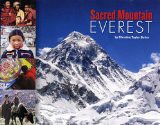

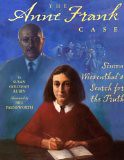

I saw some of your pics on Facebook, Laura, and I was truly in awe of you and your travels. I hope you’ll blog about some more things that happened on this amazing journey. I’d love to learn more. Hugs from the sunny Algarve x
Thanks for the kind words, Suzy :D Missed you. It really warms my heart when people say that they have been affected by the journey. I am going to blog about the trip and what it’s meant to me. Thanks for the encouragement and support, my friend. And damn! I wish I had time to see you in Portugal. I’m off to Nepal in Nov, so maybe I’ll swing by on the way home? xo
Gosh you’ve really got into the whole world travelling thing, haven’t you??! Nepal in November? WOW!! Yes, please do stop in Portugal for a few days :) It would be wonderful to finally meet you!
I’m actually coming to the States in December! We’re flying into Washington DC on my birthday (Boxing Day) and staying there a week before taking a drive south, eventually heading into Savannah, Orlando (the Wizarding World of Harry Potter awaits!!!) and Miami! I’m so excited!! <3 <3
Yes, I have. Ok…you’ve got it! I’ll see you in Portugal What a wonderful trip? Your first trip to The States? Not coming to California, huh? Well, I’ll never forgive you…hee-hee….what a wonderful way to celebrate your birthday. Savannah has a special place in my heart because that’s where I met the rest of the Paranormal Plumes….and had my TV debut with my buddy Nichole Chase :D http://laurasmagicday.wordpress.com/2011/10/27/diary-of-debut-authors-nicole-and-i-have-our-tv-debut-in-beautiful-savannah/